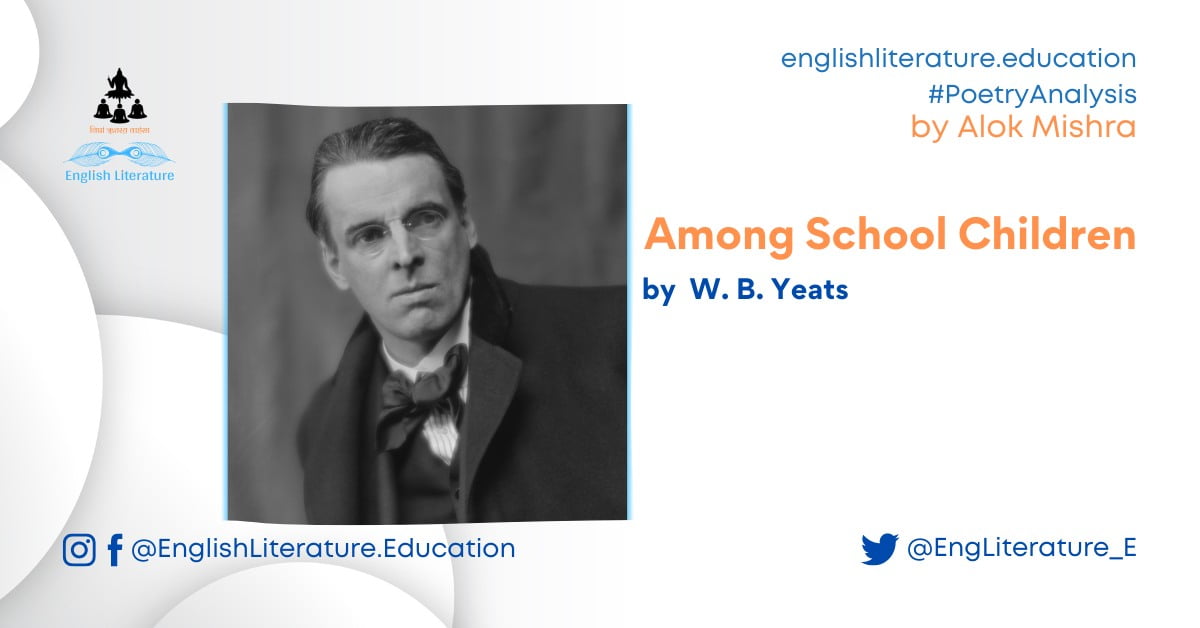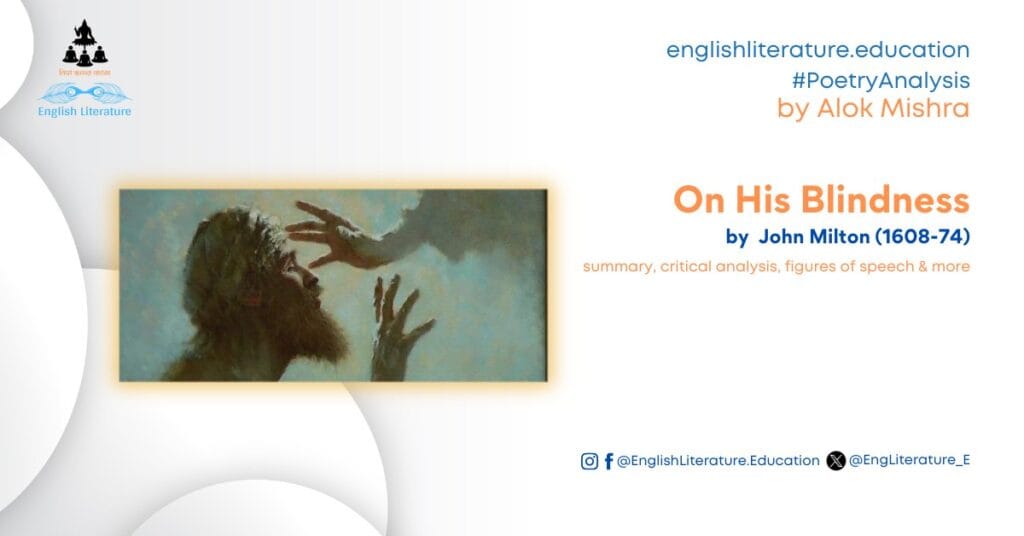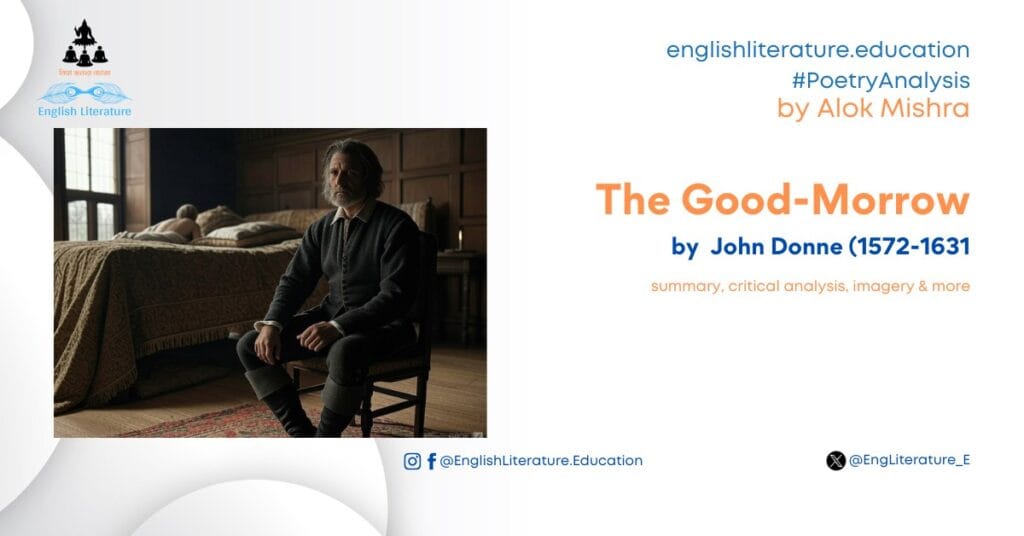This article is for those students who are seeking to uncover the critical, mythological and philosophical layers in the poem Among School Children by W B Yeats. Please note that I have already covered critical summary, line-by-line summary, explanation and poetic devices used in the poem in a detailed and comprehensive article. Click below to read that one if you are a BA English literature student or this is your first interaction with the poem.
Among School Children Summary, Critical Analysis & Poetic Devices
Now, if you want to explore complex themes and layers in the poem, continue reading this detailed and comprehensive article that unearths the symbolism, deep meanings, critical and philosophical ideas and many other things employed by W B Yeats in his iconic poem Among School Children. Let’s begin with a critical introduction to the poem.
Critical Introduction to the Poem Among School Children:
“Among School Children” by W.B. Yeats stands as a magnum opus in the canon of modernist poetry, intricately weaving together profound themes, rich symbolism, and lyrical beauty. Yeats, a master of poetic craftsmanship, delves into the complexities of human existence with a nuanced exploration of time, ageing, and the quest for spiritual transcendence. The poem unfolds within the backdrop of a schoolroom, serving as a metaphorical space where the poet confronts the multifaceted layers of life’s journey. Yeats employs vivid imagery and historical allusions, invoking classical philosophers like Plato and Pythagoras, to deepen the poem’s intellectual terrain. The thematic depth is accentuated by the poet’s introspective gaze, contemplating the transience of youth, the enduring impact of memory, and the perennial quest for artistic and spiritual immortality. The intricate interplay of personal reflection and universal inquiry renders “Among School Children” a profound and expansive work, inviting readers to unravel its layers and engage with the timeless questions it poses about the human condition.
Comments on Themes in Among School Children:
“Among School Children” by W.B. Yeats encapsulates a tapestry of profound themes, skilfully interwoven with literary finesse. At its core, the poem grapples with the inexorable passage of time, reflecting Yeats’s preoccupation with the cyclical nature of life and the perpetual struggle against mortality. The symbol of the “school children” serves as a metaphor for the transient stages of human existence, embodying the universal journey from innocence to experience. Yeats employs allusions to classical philosophy, notably Plato, infusing the poem with intellectual depth as he contemplates the dichotomy between the temporal and the eternal. The theme of artistic immortality emerges as a leitmotif, with the poet seeking transcendence through the creation of enduring art, echoing the broader modernist concern with the redemptive power of creativity. The poignant exploration of love, memory, and the intersection of the personal and the cosmic further enriches the thematic tapestry, making “Among School Children” a masterful exploration of the complexities of the human condition within the larger cosmic order. In the grand tradition of Yeats’s oeuvre, this poem resonates with a timeless, universal significance, inviting readers into a contemplative journey that transcends temporal and cultural boundaries.
One of the central themes is the passage of time and its impact on identity. The image of the “sixty-year-old smiling public man” in the first stanza encapsulates the juxtaposition of youth and age, innocence and experience. The children’s “momentary wonder” mirrors the fleeting nature of youth, while the ageing figure represents a life lived in the public eye. This duality sets the stage for Yeats’ contemplation of the human condition.
The recurring motif of the Ledaean body, drawn from Greek mythology, adds layers of meaning to the poem. The reference to Leda and the Swan, a tale of violation and transformation, becomes a metaphor for the harsh realities and transformative events that shape human existence. This mythological allusion allows Yeats to delve into the profound connection between personal experiences and the broader archetypes that define our collective consciousness.
Yeats employs vivid imagery, such as the “Quattrocento finger” in the fourth stanza, to address the transience of physical beauty and the inevitability of ageing. The poet’s acknowledgement of his own past attractiveness and the dismissal of it as a “comfortable kind of old scarecrow” exemplifies a mature acceptance of the inevitability of ageing and the changing perceptions of beauty.
The poem’s engagement with philosophical ideas, as seen in references to Plato, Aristotle, and Pythagoras, adds intellectual depth. Plato’s notion of nature as a “spume,” Aristotle’s engagement with a “king of kings,” and Pythagoras’ musical associations provide a framework for Yeats to reflect on the disparity between abstract intellectual pursuits and the messy, unpredictable nature of life.
The symbolic significance of images, whether worshipped by nuns or mothers, forms a crucial aspect of the poem. The contrast between the images lit by candles and those that animate a mother’s dreams captures the tension between external, often idealised, representations and the internal, deeply personal realm of emotions. This duality emphasises the capacity of images to inspire and break hearts simultaneously.
Yeats’ exploration of the relationship between the dancer and the dance in the final stanza serves as a fitting conclusion. The metaphor questions the nature of existence, challenging the reader to contemplate whether the beauty and wisdom derived from life are intrinsic or mere products of external circumstances.
Hinduism, the Hindu Philosophy and Yeats’ Romance with Atmgyana:
“Among School Children” by W.B. Yeats, while not overtly aligned with Hinduism, intricately weaves themes that bear resonance with certain philosophical tenets of the Hindu tradition. The cyclicality of life, a core concept in Hinduism encapsulated by samsara, is subtly mirrored in the poem’s exploration of time’s inexorable passage and the perpetual cycle of learning, maturation, and ageing. The speaker’s profound engagement with philosophical ideas, as epitomised by references to Plato, Aristotle, and Pythagoras, echoes the Hindu quest for knowledge and spiritual enlightenment, aligning with the broader pursuit of self-realisation (moksha). The poem artfully navigates the tension between the eternal and transient facets of existence, reminiscent of Hindu thought that grapples with the dichotomy of the enduring and ephemeral. Furthermore, the mature acceptance of ageing within the verses resonates with Hinduism’s emphasis on embracing the diverse stages of life. The acknowledgement of the inevitability of change and the fleeting nature of physical beauty aligns with the Hindu directive to detach from the material world. Mythological allusions, notably the reference to Leda and the Swan, though not directly Hindu, draw parallels with Hindu literature’s use of myths to convey profound truths and archetypal experiences. It’s imperative to recognise that Yeats, entrenched in Irish and Western literary traditions, likely drew inspiration from a myriad of sources, and any semblance of parallel with Hinduism may be symbolic rather than explicit. “Among School Children” unfolds as a universal exploration of the human condition, transcending cultural and religious boundaries, and offering poignant reflections that resonate with the complexities of existence.
Comparing Yeats’ Among School Children to Other Poems by Him and Other Poets:
Comparisons with other works by Yeats reveal recurring themes in his poetry, such as the exploration of Irish mythology, the cyclical nature of history, and a fascination with mysticism and the occult. “Sailing to Byzantium,” another significant work by Yeats, shares thematic elements related to ageing and the quest for artistic immortality. However, “Among School Children” stands out for its introspective and philosophical depth.
When considering parallels with other poets, T.S. Eliot’s exploration of time and memory in “The Love Song of J. Alfred Prufrock” comes to mind. Both poets grapple with the complexities of existence, using symbolic language and historical or mythological allusions to convey their messages. The thematic intersections between W.B. Yeats’ “Among School Children” and T.S. Eliot’s “The Love Song of J. Alfred Prufrock” become evident through their shared exploration of time, memory, and the intricacies of human existence. Both poets delve into the profound complexities of life, utilising symbolic language and drawing upon historical or mythological allusions to convey their nuanced perspectives. In “Among School Children,” Yeats grapples with the passage of time and the cyclical nature of life, using the metaphor of a schoolroom to encapsulate the various stages of human development. Similarly, Eliot’s “Prufrock” contemplates the inexorable march of time and the impact of memory on individual identity, portraying the titular character’s introspective musings as he navigates the complexities of modern life. The allusions in both poems, whether to classical philosophers in Yeats’ work or to Dantean imagery in Eliot’s, serve as symbolic touchstones that deepen the thematic resonance and contribute to a broader understanding of the human condition. While Yeats employs references to Plato and Pythagoras to underscore his philosophical inquiries, Eliot draws upon the rich tapestry of Dante’s “Inferno” to convey Prufrock’s existential dilemma. The parallels between these poems lie not only in their thematic concerns but also in their innovative use of language, symbolism, and historical or mythological references to illuminate the complexities of the modern psyche. Both Yeats and Eliot, stalwarts of modernist poetry, employ their distinct voices to navigate the labyrinth of human experience, leaving an indelible mark on the literary landscape of the early 20th century.
In conclusion, “Among School Children” stands as a masterpiece of modernist poetry, showcasing Yeats’ profound reflections on life, ageing, and the interplay between the personal and the universal. Through rich symbolism, philosophical engagement, and linguistic brilliance, Yeats invites readers to contemplate the complexities of the human experience, leaving an indelible mark on the landscape of 20th-century poetry.
Written by Alok for English Literature Education
**




